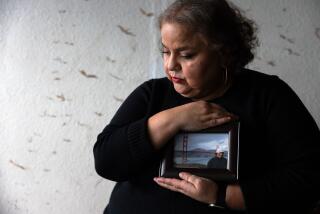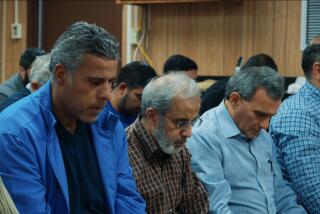What Tashfeen Malik’s visa application reveals about the San Bernardino killers
Reporting from Washington — They had only met online — first on a matrimonial website, and then in what he called “several weeks of emailing” — when Syed Rizwan Farook first sat down with Tashfeen Malik during his pilgrimage to Mecca, Islam’s holiest city, in October 2013.
They got engaged that same day, and the couple disclosed extensive personal details, including her birthplace in a historic Pakistani town and his Social Security number, when Farook filled out a K-1 fiancee visa application so he could bring Malik to Riverside to marry him the following summer.
But the 21-page application and supporting documents gave no hint of whether Farook and Malik’s then-secret commitment to violent jihad, rather than romance, brought them together in a conspiracy two years before they carried out a rampage that left 14 people dead in San Bernardino.
That, together with their motive for shooting his co-workers at the Inland Regional Center on Dec. 2, and their whereabouts for nearly four hours before police spotted their car and killed them in a shootout, are among the key unanswered questions three weeks after the deadliest terrorist attack on U.S. soil since 2001.
The documents were released Tuesday as FBI Director James B. Comey visited San Bernardino for a briefing from agents from the Los Angeles field office.
The paperwork doesn’t appear to substantiate charges from some Republican lawmakers that immigration officials failed to catch errors on the visa application that should have blocked Malik’s entry, and that the Obama administration thus allowed a budding terrorist into the country.
The FBI has concluded that Farook and Malik separately radicalized on the Internet as early as 2011, largely from English-language sermons and other material posted online by Al Qaeda in the Arabian Peninsula. The Times also has reported that Malik sent private messages to friends on Facebook in 2012 and 2014 expressing support for jihad.
Farook also had considered a terrorist spree in Southern California long before the two met. He hatched plots to gun down drivers on the 91 Freeway and butcher students at a community college in Riverside, according to a federal indictment against Enrique Marquez, who bought the semiautomatic weapons used in the San Bernardino attack.
None of that evidence came to light before the shootings, however, and Comey has said the couple appeared on no terrorism or criminal watch lists that would have led to greater scrutiny by law enforcement and intelligence agencies.
On the K-1 visa application form, Farook answered “no” to questions of whether he had ever committed “homicide, murder, manslaughter” or other crimes, including illegal drug use and domestic violence.
The application provides the first public look at the evidence that Farook, a U.S. citizen born in Chicago, gave immigration officials to prove he and Pakistani-born Malik had met in person and were planning to marry.
In his two-paragraph “intention to marry statement,” Farook wrote that he and Malik had found each other on a matrimonial website and that they met in person on Oct. 3, 2013, when he was on the Hajj pilgrimage to Mecca, the birthplace of the prophet Muhammad and of Islam itself.
“My fiance and her family drove from Riyadh to Mecca so that we could meet and it is on this day that we got engaged,” he wrote.
He said they met at a relative’s home near the Ajyad Hotel, a high-end hotel close to the central Masjid al-Haram, which contains Islam’s most sacred shrine.
Farook said they did not use the services of an international marriage broker.
He said he had worked as an environmental technician from June 2011 to January 2012 for the Kasai Consulting firm in Carlsbad and then as an environmental health specialist for San Bernardino County beginning in January 2012.
He signed the documents “S. Farook” in several places, and dated the application Jan. 20, 2014.
Malik is not covering her face in her passport or visa photographs.
The file includes copies of their Saudi visas and entry and exit stamps, which were in Arabic.
A U.S. Citizenship and Immigration Services official in Laguna Niguel requested a translation of the Saudi entry and exit stamps. The file contains a translation of their Saudi visas, but not of the entry-exit stamps. The visa was approved without them.
The couple had a religious wedding ceremony at the Masjid al-Haram — the largest mosque in the world — in Mecca. After Malik’s six-month visa was approved, she flew to America. Her entry visa was stamped at O’Hare International Airport in Chicago on July 27, 2014.
Less than a month later, on Aug. 16, 2014, the couple obtained a marriage certificate from Riverside County. Malik later applied for a lawful permanent residency visa.
At that point, Saudi officials confirmed to Homeland Security authorities that the couple were both in Saudi Arabia in October 2013, as their application had claimed.
“Tashfeen Malik’s immigration file contained sufficient evidence to establish that she intended to marry Syed Farook and that the two were together in Saudi Arabia before the fiancee petition was filed,” Joseph R. Holstead, a spokesman for U.S. Citizenship and Immigration Services, said in a statement Tuesday.
Some information in the file was blacked out for release, including Farook’s Social Security number, contact information for his parents, and telephone numbers and email addresses.
The file was released by the House Judiciary Committee, which is investigating whether the visa was issued properly. Some Republican lawmakers have charged that Malik failed to meet the legal requirements to be issued a visa.
Sen. Charles E. Grassley (R-Iowa), chairman of the Senate Judiciary Committee, said at a Dec. 10 hearing that it appeared Malik had given a false home address on the application, and thus should have been denied a visa.
“Our government apparently didn’t catch the false address in Pakistan she listed on her application or other possible signs that she was radicalized or an operative,” Grassley said.
In the application, Malik wrote that she lived at Awad House, 110-B, Babar Colony, MDA Chowk, in Punjab, Pakistan, between November 2009 to June 2013, and from October 2013 until December 2013, when she filled out the form.
She said she lived in Riyadh, Saudi Arabia, in the intervening months, apparently with her father.
Malik said she was born on July 13, 1986, in Dera Ghazi Khan, a town famed for its historic mosques and tombs, on the western banks of the Indus River in southern Punjab province.
No evidence has shown those addresses were false, and aides to Grassley have since suggested that he was inquiring after hearing media reports that she had given incorrect addresses.
Rep. Robert W. Goodlatte (R-Va.), chairman of the House Judiciary Committee, insisted Tuesday that immigration officials had failed to check the application carefully enough.
Without the requested translation of the Saudi entry and exit stamps, he said, the immigration officer didn’t have enough evidence to show the two had met in person, as required for the K-1 visa.
“Visa security is critical to national security, and it’s unacceptable that U.S. Citizenship and Immigration Services did not fully vet Malik’s application and instead sloppily approved her visa,” he said in a statement.
In response, Rep. John Conyers Jr. (D-Mich), ranking member of the Judiciary Committee, said Goodlatte’s claims “are not supported” by the facts.
“We have reviewed the suspect’s immigration file, and found that it included relevant evidence such as passport stamps, biographic data, and translated Saudi visas submitted in response to [the] request for further evidence,” he said.
The couple initially lived in Riverside, but moved to Redlands this year, about the time they had a baby.
A neighbor, Annie Frost, said she only saw them, or Farook’s mother, a handful of times, and they barely spoke.
“I met the mother ... I met the wife,” said Frost, who lived next door to the family. “She was not as nice or engaging.”
Frost, 38, said she sometimes spotted Malik walking to the family’s black Lexus, or coming back from a grocery store with her mother-in-law. Malik, she said, did not cover her head or face as some devout Muslim women do.
The last time she saw her, Frost said, Malik wore black pants and a peach-colored long-sleeved shirt, with her chocolate-brown hair falling at her shoulders.
“She was never covered,” she said. “The mom wore a head scarf.”
After an intelligence briefing last week, two congressmen said neighbors of the shooters had told investigators they had witnessed “suspicious activity” at the couple’s home before the attack, but did not report it to authorities.
Frost said she told the FBI that Farook and his wife had at least five packages delivered in the days before the shooting, and several sat in a pile on their doorstep. She said she had no reason to consider it suspicious.
“What would you report? Other than he has a long beard, wears regular clothes and works in the garage?” she asked, adding that Farook liked to work on his car there.
The last time Frost saw her neighbors was the Sunday before the mass shooting. Malik stepped outside to call her husband in because their 6-month-old baby had done something amusing.
Both were smiling, Frost recalled.
“That’s why it’s hard to think that [a terrorist plot] would be going on next door,” she said.
Bennett and Serrano reported from Washington; Parvini from Redlands.
MORE ON SAN BERNARDINO:
Hear the first moments after the attack
A freeway terror attack is the ‘nightmare we worry about,’ law enforcers say
After massacre, Marquez made dramatic 911 call
More to Read
Sign up for Essential California
The most important California stories and recommendations in your inbox every morning.
You may occasionally receive promotional content from the Los Angeles Times.













